AIDS Walk’s afoot in WeHo
October 10, 2012
The 28th Annual AIDS Walk Los Angeles will fill the streets of West Hollywood with more than 30,000 supporters this Sunday. Celebrities and local officials will be among those hitting the pavement to add to the more than $72 million the event has raised since 1985.
The walk has been shortened this year to accommodate the space shuttle Endeavour, which is making its way to its new retirement home at the California Science Center. Nevertheless, some streets will be closing for the event. Starting at 6 a.m. on Sunday, sections of La Peer Drive and Melrose Avenue will close, as will parts of Robertson, Santa Monica, San Vicente, Beverly and Fairfax. To allow for set-up, San Vicente will also close between Santa Monica and Melrose at 6 a.m. on Saturday and from Santa Monica to Cynthia Street at 12 a.m. on Sunday morning. All roads will reopen when it’s safe to do so. Click here to see a map of the walk’s route.
There is still time to join or donate to AIDS Walk L.A. Sign-in begins at 8:30 a.m. on Sunday, October 14. Visit the event’s website for more information.
Posted 10/10/12
The real work starts now
October 4, 2012
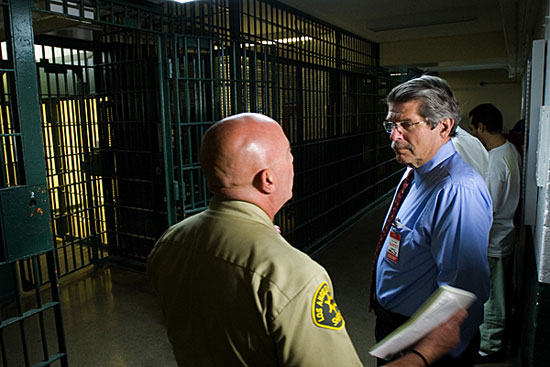
Supervisor Yaroslavsky visits Men's Central Jail shortly after creation of the blue-ribbon commission.
One year ago this month, the controversy over alleged deputy brutality inside the jail was threatening to utterly erode public confidence in the constitutional performance of the Los Angeles County Sheriff’s Department, our region’s largest law enforcement agency.
Not only were inmates accusing deputies of bone-breaking beatings but civilian observers—including a jail chaplain—had provided the American Civil Liberties Union with affidavits saying they’d witnessed fierce and unprovoked attacks. There were also revelations of a federal investigation into the widening allegations.
Under increasing fire, Sheriff Lee Baca publicly said at the time that his command staff had kept him in the dark about the problems but that he was determined to bring order and integrity to the county’s massive jail system—an entirely credible pledge given the sheriff’s longtime advocacy for inmate educational programs. To get to that point, however, would be no easy task.
In the midst of the uproar, I called Sheriff Baca and asked if I could meet with him in his office in Monterey Park. I arrived two hours later with a specific idea to help restore public trust in the department and in the broader leadership of the county, including the Board of Supervisors. One-on-one with the sheriff, I suggested that the board create a no-holds-barred blue-ribbon commission to investigate the origins of the jail problems and recommend reforms for the future. I believed that, with the sheriff on board, he’d be more likely to support the outcome.
He didn’t hesitate for a moment. Let the chips fall where they may, he said. Within days, I introduced a board motion with my colleague Mark Ridley-Thomas to create the Citizens’ Commission on Jail Violence. Its mandate: to excavate and expose the truth.
Last week this distinguished panel of seven commissioners released its final report. And it was, as we requested, unflinching in its assessment of what went wrong and what must be fixed. The bottom line was this: multi-faceted breakdowns in the management of the county’s jails—and deep flaws in the department’s disciplinary system—had created an environment ripe for unchecked brutality by deputies. The commission placed responsibility for these failings squarely on Baca and his second-in-command, Undersheriff Paul Tanaka. “Simply stated,” the panel wrote, “the Sheriff did not pay enough attention to the jails until external events forced him to do so.”
What makes the commission’s conclusions particularly difficult to ignore or dismiss is that they were rendered with unanimity by panelists of varying demographic and political stripes, from federal judges appointed by Republican and Democratic administrations, to the chief of police of Long Beach to a revered pastor in South Los Angeles.
Yesterday, Sheriff Baca summoned the media to Men’s Central Jail to comment publicly for the first time on the report, which not only took him to task but offered more than 60 recommendations for reform, including more rigorous independent oversight. “I couldn’t have written them better myself,” Baca said, reminding reporters that “I wanted this commission as much as the board did.” As he has done repeatedly over the past months, Baca again acknowledged his failings in the matter.
I appreciate and respect the sheriff’s willingness to publicly take responsibility for his department’s shortcomings, an admirable and longstanding characteristic of his management style. But the occasion at hand calls for more than words of contrition or pledges of reform that could fall short of their expressed ideals without sustained, aggressive action on the sheriff’s part.
The jail commission noted that their final report actually is just a starting point, something that all of us with a public responsibility—and a duty to uphold constitutional rights—should keep in mind. I pledge my support to do whatever I can to work with the Sheriff’s Department to bring about the kind of structural and cultural changes the commission has recommended. And above all, we must avoid the outcome the panel fears most: that the report will collect dust on a shelf, like too many reform efforts of the past.
Posted 10/4/12
Street fighting man
October 4, 2012
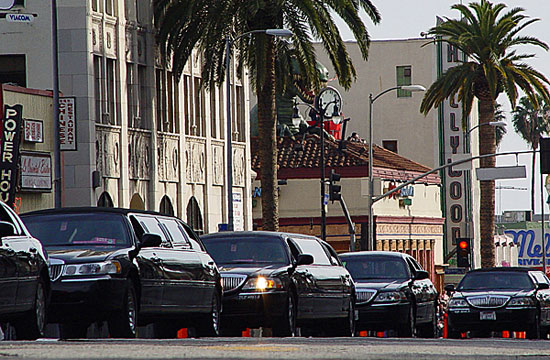
The annual Oscar challenge: getting the limos to the Academy Awards safely and on time. Photo/Hebig via Flicrk
In this, the land of cars, all roads lead to Aram Sahakian.
With one false move, one slight miscalculation, he could bring L.A.’s traffic to a hellish halt. There are plenty of powerful jobs in Los Angeles government, but even the mayor takes a back seat to this street-smart guy when it comes to keeping the city moving.
Sahakian oversees special traffic operations for the city’s Department of Transportation and is thus responsible for mapping and implementing street closures for every big event in Los Angeles. Perhaps you know his work: Carmageddon (and next week’s sequel), the Academy Awards, championship parades for the Lakers and Kings, CicLAvia, presidential visits, the L.A marathon and, of course, The Rock’s journey to the Los Angeles County Museum of Art.
“I have an extremely understanding wife,” Sahakian says of the relentless hours and maddening deadlines of his job. “When you work for me, you better expect not to have much of a personal life.”
Now Sahakian and his small staff are preparing for one of their biggest logistical challenges—getting the retired space shuttle Endeavour from LAX to its new home at the California Science Center in Exposition Park. The shuttle is scheduled to arrive at the airport on Friday. On October 12, it will start a two-day journey to the Science Center, passing through Inglewood and into Sahakian’s turf.
Already, hundreds of trees are being felled to accommodate Endeavour’s 78-foot wing span. But that’s just the beginning. Sahakian says that once Endeavour actually gets rolling on its low-slung, remote-controlled transport, nearly 50 traffic signals along the route will have to be rapidly taken down as the shuttle approaches and then immediately restored after it passes—all in a single day.
“There’s no room for error,” says Sahakian, a 23-year veteran of the department. “If we get a picture in the Los Angeles Times showing the shuttle stuck because of a signal standard, this would not be good.”
In recent days, another complication has surfaced: Sophisticated tests of the streets along the route through South Los Angeles and downtown have revealed vulnerabilities beneath the surface, where sewer and water lines are located. These 14 areas, Sahakian says, could become sink holes under Endeavour’s 78 tons. This would not be good, either.
To fix the problem, Sahakian says that at least 150 plates of thick steel will be placed under the transport’s wheels to distribute its weight along the worrisome stretches. “And I’m not talking about a couple spots here and there,” Sahakian says. Details of the effort are still being worked out, but he expects the entire intersection of Crenshaw and Martin Luther King boulevards to be covered with steel.
Although the logistics of all this may seem dizzying, Sahakian says he has a bigger concern. “This is a cakewalk,” he says of the tightly choreographed traffic plan. “We can do this in our sleep. The big unknown is the crowd.”
Sahakian, who also oversees emergency response for his department, worries that thousands of people could turn out for the once-in-a-lifetime spectacle of the shuttle’s 12-mile urban journey. But this is not like artist Michael Heizer’s granite rock, which drew huge crowds during its slow-motion trip to LACMA, where it became the 340-ton centerpiece of “Levitated Mass.” In the shuttle’s case—because of its width and NASA’s desire to keep the public at a safe distance—there’ll be few places to stand, except at the end of streets that intersect the route or in designated viewing areas.
“What I worry about,” Sahakian says, “is a Rose Parade situation where we’ll have thousands of people out there with no place for them to park or see the shuttle.”
These are the kinds of scenarios that can haunt a planner’s waking—and sleeping—hours. Sahakian says that whether it’s the Endeavour project or the many others he’s constantly juggling, he may get an idea in the middle of the night. “Sometimes, I’ll send emails at 3 a.m. so I don’t forget,” he says.
Sounding more like an inspirational speaker (a la John Wooden) than a traffic engineer, Sahakian says his motto is: “Not planning is planning for disaster.”
Consider the Oscars. It is Sahakian’s job, among other things, to make sure that the fleets of limousines ferrying nominees and other VIPs don’t get tangled up outside the Dolby Theatre, formerly the Kodak, on Hollywood Boulevard. To that end, he has created a “serpentine” of concrete K-rail, through which each limo must slowly (but not too slowly) pass in an orderly fashion—a technique he’ll also be employing for this weekend’s Emmy Awards at Staples Center.
But the planning begins long before the stars emerge from their luxurious rides. “One of the most important elements of traffic planning,” he says, “is to know where people are coming from so you can facilitate the route.” That’s why his crew jotted down limo license plate numbers a few years back and studied their points of origin. Not surprisingly, most were arriving from the Westside.
Sahakian is not necessarily expecting any awards from the motoring public for his efforts. “If it’s a Lakers parade, they’re happy,” he says. “If it’s a 5K fundraiser, they’re not so happy.”
More often than not, he hears, “You guys are messing up the whole city.” Or maybe, “Whose bright idea was this?”
Still, he knows—even if the public doesn’t—that things could be a lot worse.
Last week, in his cramped office on the edge of downtown, Sahakian told a visitor that he’d recently worked with organizers of the hugely popular CicLAvia to change the date of its latest event, which was scheduled for the same October weekend as Endeavour’s journey. “Thank God CicLAvia agreed to move up its date” to October 7, Sahakian said with obvious relief.
A few hours later, however, his visitor got an email that spoke volumes about the man and his work. “Just to make it more interesting,” he wrote, “now I have Obama visiting on 10/7. Yes, Ciclavia :)”

Endeavour on its way to L.A., where Sahakian will help orchestrate its final journey. Photo/Los Angeles Times
Posted 9/19/12
And hold the extra calories
October 4, 2012
Quick: How many calories should an average adult consume daily? Should growing boys and girls eat more than their parents or less?
If you didn’t know that 2,000 calories a day is plenty for most adults and that most children need even fewer, keep your eyes out for Los Angeles County’s latest front in the surging obesity epidemic—a sweeping new public education campaign aimed at getting people to reduce their food portions.
The initiative was launched last week in Spanish and English on billboards, buses, web banners and other media. And it’s coming none too soon, according to a new report from the Los Angeles County Department of Public Health.
In a survey released this week, public health officials found that adult obesity rates here have risen by 74% since 1997, when the county first began tracking the problem. Obesity now afflicts nearly a quarter of Los Angeles County’s adults, with rates in some parts of the county exceeding 30%.
In South L.A., for example, about one adult in three is obese now. In East L.A., the rate is 30.1%. In the Antelope Valley, which has the county’s biggest weight problem, the rate has more than doubled to nearly 35%—roughly the same as Mississippi’s. (The Westside, by comparison, has an obesity rate of less than 10%.)
The local findings correlate with trends across the nation, where the overall obesity rate—the percentage of people with an overall body mass index of 30 or higher—has reached epic proportions. Obesity is approaching tobacco use as the leading preventable causes of death in the U.S., and its attendant medical costs are estimated at $147 billion to $210 billion a year.
A recent state-by-state projection by the Robert Wood Johnson Foundation found that if Americans continue on the current trajectory, obesity rates could top 44% within the next two decades in every state in the nation, including California, and more than half of the states could have obesity rates of more than 50%.
The situation, which is not only shortening lives but threatening efforts to contain healthcare costs, has prompted national, state and local intervention. New York, which has been in the movement’s forefront, recently became the first city in the nation to ban the sale of sugary drinks larger than 16 ounces and has launched a push to get rid of sugary and fatty food in hospitals.
In Los Angeles County, initiatives have ranged from ads depicting the amount of sugar in non-diet sodas to campaigns to improve nutrition in day care centers and pre-schools. The result, the public health department report notes, has been “a hint of a decline” in children’s obesity rates.
But Paul Simon, Director of the DPH Division of Chronic Disease and Injury Prevention, says that, even at its current plateau, childhood obesity here remains a profound problem and that’s “no evidence the obesity epidemic among adults in the county is stabilizing.”
“The rate of increase may be slowing,” he says, “but it’s still going up.”
Consequently, health officials are going back to basics in trying to educate the public on the kinds of habits that make people overweight. The current campaign, expected to cost slightly less than $1 million, is being funded by a grant from the Centers for Disease Control and Prevention and managed by the county’s Choose Health LA campaign.
“Obesity is a problem that starts early,” says Simon, “and one that continues to get worse with time. So we are doing many different things to address it. Portion control isn’t the only intervention, but it’s an important one.”
Portion sizes have ballooned over the last two decades. (For an eye-opening quiz, click here.) Study after study has shown that larger portion sizes make us eat or drink more. Even a feeling of fullness won’t stop us.
“We’re wired to eat what’s on our plate,” says Simon. And, he says, most of us don’t have a clue how many calories we’re consuming. To test market their campaign, DPH convened two local focus groups, in Spanish and English, and conducted an online survey with nearly 700 Los Angeles County respondents. One of the most startling discoveries was that most Angelenos don’t even know how much they can eat—or feed their children—without gaining weight. Some respondents thought 4,000 calories a day was the recommended allowance, others were sure it was more like 500.
In fact, the U.S. Department of Agriculture estimates that adult women only need 1,600 to 2,400 calories per day, and adult men only need 2,000 to 3,000. Young children need only 1,000 to 2,000. And unless you’re an athlete, you should be saying “when” at the lower end of those ranges. A grand-slam breakfast, a 12-inch sandwich, three slices of pizza, a bowl of spaghetti with two meatballs, a double-double with large fries—for most people, any one of these could, in a single sitting, dish up half of a full day’s calories.
But a second discovery, borne out in other studies, was that too harsh or challenging a message would simply cause some people to tune out. So the county campaign took the unconventional step of including ways to cut calories from the kinds of meals people were actually eating, as opposed to the healthier food they should eat.
The campaign’s images are not of broccoli and kale, but of smaller burgers and fewer slices of pizza, shown with their respective calorie counts next to the motto “Choose Less. Weigh Less.” Simon says the message is not necessarily to give up fast food and big restaurant portions, but to consider splitting an order, choosing a smaller plate or asking the server to put half in a to-go bag before bringing your food to the table.
The campaign is expected to get a boost from the federal health care reform law, which was upheld by the U.S Supreme Court this summer. Among the pending requirements of the Affordable Care Act is one that will require calorie counts to be posted in all chain restaurants with more than 20 outlets. (California has had a calorie-count law for nearly two years. But its implementation has been slowed because the new federal law has pre-empted it, as it has a county ordinance championed by Supervisor Zev Yaroslavsky.)
Though the fast food industry has, in general, resisted the posting of such information, a few chains, such as Panera Bread and McDonald’s, have voluntarily begun posting calorie counts on menus. This summer, McDonald’s experimented with a “Favorites Under 400” promotion of menu items with 400 calories or less.
Simon says that, down the road, the county might be able to build on that commercial involvement by encouraging restaurants to broaden their range of small-plates, offer half-orders or give patrons the option, before their food comes to the table, to save half of their entrée in a take-out box for later.
Yaroslavsky, a supporter of the county’s anti-obesity efforts, says the campaign “is one of many public health initiatives the County of Los Angeles is pursuing to help make our communities healthier.”
“Our aim is to give people access to healthy foods and beverages where they live, work and play.”
Posted 10/2/12
The county ballot from ALF to Z
October 4, 2012
When Santa Monica-Malibu Unified School District officials got the word that their upcoming bond measure would be designated FF on the November ballot, they felt like parents confronted with a bad report card.
“FF sounds like double fail,” said school board president Ben Allen. “We’re trying to help kids succeed.”
Fortunately, they were able to get the designation changed to ES, evoking “education” and “schools,” much to the relief of those backing the measure.
“It works great,” Allen said. “You want voters to consider these measures on their merits.”
In a busy presidential election year like this one, with 42 local and 11 statewide measures going before Los Angeles County voters, the ballot could, to the uninitiated, resemble a bowl of alphabet soup. But there’s a method to the distribution of letters.
And requests to change the original designations come in all the time.
“We do get requests from all kinds of jurisdictions in the county, and we get very specific requests,” said Alex Olvera, division manager for election information and preparation for the Registrar-Recorder/County Clerk. “In L.A. County, we always allow jurisdictions to make a 1st, 2nd and 3rd choice.”
“A and B are the most requested,” he said. Some jurisdictions, especially school districts, add a special plea: “Whatever we get, just don’t give us D or F.”
Early planning is helpful. The city of Inglewood, for example, put in its request well in advance to get the letters IT assigned to a 2006 sales tax measure—enabling a successful pitch to “Vote for IT.”
This year, Sierra Madre officials secured a relatively rare three-letter designation, ALF, to go with a measure asking voters to decide whether to allow development of an assisted living facility.
Priority in assigning letters goes to countywide measures. This year, Measure A is an advisory measure that asks voters to consider whether to make the county assessor an appointed position.
Measure B is the so-called Safer Sex in the Adult Film Industry Act, which would require the use of condoms on porn shoots. (And no, county election officials didn’t even consider labeling that one Measure X. That designation is going, instead, to a Pomona measure asking voters to approve a parcel tax to support library services.)
It was the Pomona Unified School District, meanwhile, that drew one of the more regrettable designations for a ballot measure in recent memory.
“We had assigned the measure PU, and it was not endearing to the school district,” Olvera said.
The alternative designation—PS—passed the smell test and was approved by local voters in 2008.
Posted 8/22/12
The grandest opening of them all
October 4, 2012
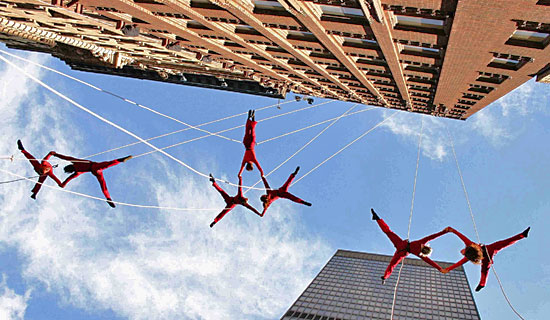
Bandaloop brings its aerial artistry to City Hall on Saturday, for the opening of Grand Park's final segment.
It’s been rolling out, bit by bit, since mid-summer, but this weekend, Grand Park will finally get the grand opening Los Angeles has been waiting for.
As the third and final section of the 12-acre space opens to the public, a festive block party is being planned on Saturday, October 6, from 4 p.m. to 9 p.m., with dancing around the fountain, Cuban jazz on the lawn, food trucks on the street and, at the park’s eastern boundary, a soaring aerial ballet up the sides of L.A.’s iconic City Hall. Then on Sunday, the park will leap into action as a hub for the wildly popular CicLAvia.
“It’s really exciting,” says Dawn McDivitt, who has managed the park project for the county’s Chief Executive Office. “The opening of the first two blocks in July drew 5,000 people in the first weekend, and we think this weekend will draw even more.”
Stretching from City Hall to the Music Center, the new park—an inviting 4-block rectangle of grass, plants, water and hot pink lawn chairs—has been drawing crowds since its first segment opened this summer, offering the first substantial stretch of green space in downtown L.A.
Conceived nearly a decade ago as part of a plan to redevelop Grand Avenue with luxury hotels, condos and retail, the park moved ahead while other elements were postponed by the economic downturn, largely because of a $50 million payment that was negotiated upfront from Related Cos., the project’s developer.
The first section, opened in July, is anchored by a Starbucks and the Arthur J. Will Memorial Fountain, which features an ankle-deep membrane pool that has become a major weekend draw for nearby families. The middle section features a community terrace with a Court of Flags, a Vietnam Memorial and 24 cherry blossom trees from the Japanese Consulate. The final section, at the City Hall end, will offer a dog park and a spacious event lawn that planners already are programming for local gatherings. Also on tap for the future is an anchor restaurant or café at the City Hall end of the park.
“I think if you ask anyone, the park is already a success,” says McDivitt, noting that none of the park events so far have drawn fewer than 200 to 300 people. “And when you compare that to the mall that was there before, where, if you saw 20 people in all three blocks, you were lucky—just looking out my window at the Hall of Administration, it’s amazing. People who have driven in from their communities for events, neighborhood people from the lofts, mothers sitting around the membrane pool with their children. There are more people than I’ve seen down there in 22 years of working here.”
This weekend’s kickoff is expected to draw crowds from throughout the county, starting with 11 a.m. dance lessons at the Music Center Plaza in a salute to Latino Heritage Month.
At 4 p.m., the Grand Park celebration will officially begin with “A Fanfare for Grand Park,” a reprise of a dance performance that premiered at the park’s July dedication.
At 5:30 p.m., down the hill on the park’s performance lawn, the Latin jazz duo Dos y Mas will launch the park’s new World Jazz Series, and at 6:45 p.m. outdoor videos will be projected onto the wall of the county’s Richard Neutra-designed Hall of Records building that flanks the park.
After a welcome from public official and dignitaries, the party will move to the event lawn. There, at 7:45 p.m., the aerial dance troupe Bandaloop will perform a spectacular vertical dance on the walls of the city’s towering City Hall building, suspended hundreds of feet off the ground by climbing ropes.
Park officials view Saturday’s celebration as just the start of Grand Park’s new role as a downtown centerpiece. Programming will be handled for the first three years by the Music Center, and Park Director Lucas Rivera has predicted the park will soon be home to farmers’ markets, arts festivals, book fairs, and other regional gatherings. McDivitt says she won’t be surprised to see regular movie nights, with outdoor films projected on the Hall of Records. Already, one segment of the park is home to the downtown speakers’ series Zócalo.
Events scheduled for the near term include an October 14 Pooch Party for dogs and the people who love them on the event lawn, an October 27 performance by the AXIS contemporary dance company, a November 2 night time Dia De Los Muertos party and a November 4 arts happening called Flash Fest.
Says McDivitt: “This really is a brand new chapter for downtown L.A.”
Posted 10/4/12
Sunrise on Sunset
October 4, 2012
A wider, modernized Sunset Bridge is set to reopen for business on Monday, September 24, marking a major milestone in the progress of the 405 Project to bring a northbound carpool lane and other improvements to one of the nation’s most heavily-traveled freeways.
The rebuilt bridge will be 120 feet across—30 feet wider than its 1950s-era predecessor. In addition to two travel lanes in each direction, it also has new, dedicated turn lanes for motorists to access the freeway without affecting the flow of east-west traffic. Sidewalks and shoulders are wider, too, and the bridge has been upgraded to current seismic standards.
The bridge provides a major conduit across the Westside, with UCLA on one side and Brentwood on the other. Between 18,000 and 22,000 motorists cross it each weekday.
“It’s a lot wider and much safer,” said Mike Barbour, who is heading up the project for Metro. “It’ll be a lot more comfortable for people to get on and off the freeway.”
Monday’s reopening comes after more than two years of demolition and reconstruction work on the bridge. One final push is needed to complete the job, however, and the bridge will be closed from 10 p.m. to 6 a.m. on Friday, Saturday and Sunday nights. The bridge will be reduced to a single lane in each direction from 6 a.m. to 10 p.m. on Saturday and Sunday. Details are here.
The Sunset Bridge is the first of three overpasses to be demolished and rebuilt during the 405 Project. Demolition work on one of the others, the Mulholland Bridge, will take place on September 29 and 30 will require the weekend-long 405 Freeway closure known as Carmageddon II. Angelenos are being encouraged to “eat, shop and play locally” during the closure and to avoid driving in the area.
Posted 9/20/12
Sheriff agrees to broad jail reforms
October 3, 2012
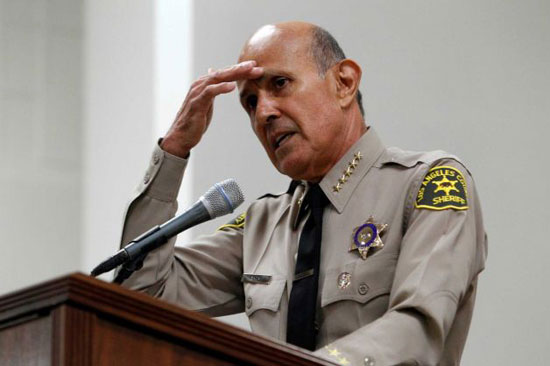
Breaking a nearly week-long silence, Sheriff Lee Baca says he applauds the commission's efforts. Photo/AP
Chastened and conciliatory, Los Angeles County Sheriff Lee Baca said Wednesday that he fully agrees with—and will begin implementing—dozens of recommendations from a blue-ribbon panel that accused him and his top command of failures in leadership that fostered a culture of brutality among jail deputies.
“I couldn’t have written them better myself,” Baca said of the more than 60 recommendations issued last week by the Citizens’ Commission on Jail Violence, which concluded a year-long investigation with a blistering report on management breakdowns inside the nation’s largest jail system.
But, in response to a question during a packed news conference, the elected sheriff brushed aside talk of a possible resignation. “I’m not a person who thinks about quitting on anything,” he said.
Baca convened the massive media gathering in the chapel of the Men’s Central Jail, an aging facility on the edge of downtown Los Angeles, where the vast majority of brutality allegations against deputies have been leveled over the years by inmates and civilian monitors, including the ACLU. As Baca spoke from the pulpit under a large cross, more than 20 members of his jail command staff sat solemnly behind him, some on risers. In the pews—behind a bank of TV cameras—were rows of inmates, dressed in L.A. County’s jailhouse blues.
It was an usually theatrical setting for the sheriff’s first response to the 194-page report by the jail commission, which was appointed by the Board of Supervisors and included former judges, a police chief and a longtime South Los Angeles pastor. And he went to great lengths not to criticize any aspect of the commission’s effort, which he said he supported from the outset. “I’m paid to take criticism,” said the sheriff, dressed in uniform. “Even when it’s unfair.”
In fact, as he has in the past, Baca was quick to accept blame for use of force issues that had been intensifying for several years. Those problems became especially acute under the leadership of Undersheriff Paul Tanaka, according to the commission. The panelists concluded that Tanaka had “exacerbated” the problems by, among other things, publicly belittling internal affairs investigators and unilaterally killing a plan to break-up deputy cliques by rotating them into new jail assignments.
“They needed me to set a higher standard for performance,” Baca said of Tanaka and other key members of his command staff, whom the sheriff said had failed to alert him to the brewing problems inside the crowded county lockup.
The commission was highly critical of Baca for not holding Tanaka and others accountable for their conduct, saying his failure to act has sent a troublesome message to the rank and file. Repeatedly pressed on that point by reporters on Thursday, the sheriff sharpened his tone. “I’m not a person who acts impulsively or in my own self interest when it comes to someone else’s career. We will either have the facts or we won’t have the facts.”
Baca, who said he is reviewing Tanaka’s conduct, added: “I don’t lead with my ego. I lead with my intellect.”
The sheriff said Tanaka, a certified public accountant who was not at Wednesday’s event, would remain with the department, overseeing administrative services and the agency’s budget, a far smaller portfolio than he once held.
Among the commission recommendations (read the panel’s executive summary here), Baca said he supports two that, in concept, would vastly enhance oversight of the jail operation.
One would create an independent Office of Inspector General reporting to the Board of Supervisors. The new agency would essentially consolidate and broaden the review responsibilities of three existing civilian bodies—the Special Counsel, Office of Independent Review and the Office of the Ombudsman. The idea for an inspector general is modeled after a watchdog agency that oversees the Los Angeles Police Department. Exactly how such a body would be created and function for the Sheriff’s Department will likely be a matter of considerable public debate.
The second recommended reform would be the creation of a new assistant sheriff position, staffed by an experienced corrections leader from outside the department. This person would report directly to Baca, who said he supports the idea and already is seeking candidates.
The commission also called for tougher discipline for excessive force and dishonesty, a simplification of the disciplinary system and creation of a new investigations division that would report directly to the sheriff.
Baca said he welcomes these recommendations as a way to make “a stronger and safer jail,” a place where deputies respect the humanity of inmates, who, for their part, can learn life skills and end the cycle of recidivism. “I do have some deputies who have done some terrible things,” he said.
Still, Baca stressed that since last October when the ACLU presented him with numerous accusations of excessive force in the jail, he aggressively instituted a series of measures that have reduced “significant force” in the jails by 53 percent—“a historic low,” he said. He said he also has initiated tough new policies while increasing supervision, video surveillance and training. Baca said he and his management team have “responded massively.” (A video of Baca’s hour-long news conference can be seen here.)
In its report, the jail commission acknowledged the significant improvements Baca had brought to the custody operation after he belatedly became engaged with the issues. But commission member Robert Bonner, a former federal judge and ex-head of the Drug Enforcement Administration, said those measures do not go far enough and that the department needs sweeping cultural and structural changes.
“The modest steps taken by the sheriff are not permanent, institutional reforms,” Bonner said during last week’s commission meeting. “They are Band-Aids—meant to staunch the bleeding.”
Posted 10/3/12
CicLAvia heads down a new road
October 3, 2012
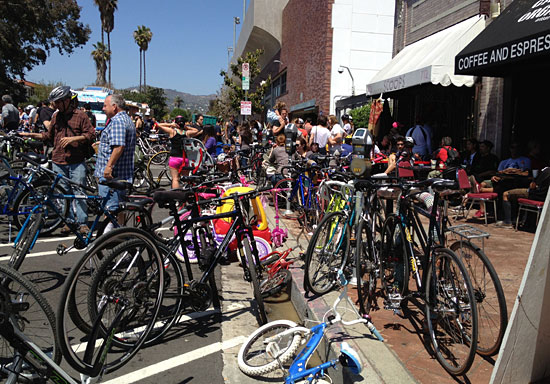
The Bicycle District is usually packed for CicLAvia but now the event is rolling out to new communities.
For the first time since its inception, the freewheeling car-free street party known as CicLAvia won’t be cycling through Los Angeles’ Bicycle District when it rolls around this Sunday.
The Heliotrope and Melrose neighborhood known for its pioneering, bike-friendly ethos and jaunty nickname “Hel-Mel” has been penciled out, this time around, in favor of a map that stretches farther south than ever before—from downtown to Exposition Park and USC. It also includes a new northerly hub in Chinatown, an eastward stretch to the Soto Gold Line station in Boyle Heights, and a stop at downtown’s new Grand Park.
As CicLAvia prepares for its fifth outing, its new map is just the most visible sign of an enterprise that’s literally on the move, stretching into new areas easily reached by L.A.’s growing public transit network. Pedestrians are taking their biggest step yet toward claiming their place on the pavement, as Los Angeles Walks sponsors a mid-day “walking parade” dubbed WalkLAvia down the middle of Figueroa from 8th Street to Exposition Park. And, with ambitious plans to expand and integrate CicLAvia more deeply into the fabric of the city, efforts are underway to significantly increase the amount of corporate support to sustain the event in years to come.
The course is actually slightly shorter this time—9.1 miles, compared to the previous 10. But clearly, CicLAvia’s cultural footprint is big, and growing, with more than 100,000 participants expected Sunday for the event, which runs from 10 a.m. to 3 p.m.
“We instantly, overnight, became the largest car-free event in the United States,” said Aaron Paley, who helped found CicLAvia and now serves as its executive producer. “We went from being an idea…to becoming something that Angelenos expect out of their city. A car-free day is now just as much a part of Los Angeles as the Venice boardwalk, or the Hollywood sign. We changed the conversation in Los Angeles.”
It was never (entirely) about the bike, Paley said, noting that three distinct groups—cyclists, environmentalists and public space planners—came together to create the original CicLAvia in 2010. They’re now being joined by many others, including health activists, as the event enters the L.A. mainstream.
“CicLAvia itself is much larger than a biking event,” Paley said.
The new route, thanks to its proximity to the recently-opened Expo Line, makes it easier for many communities to take part, said Tafarai Bayne, community affairs manager of the neighborhood action group T.R.U.S.T. South L.A. and a CicLAvia board member.
“We definitely think we’ll increase turnout from neighborhoods like South L.A. and the Westside,” Bayne said, noting a “huge surge” in youth cycling that provides a natural constituency for the event. The setting makes sense, too, he said: “We have really big, wide boulevards that this event can take advantage of.”
In the Bicycle District, a popular café, Cafecito Organico, is having to adjust to the idea that CicLAvia will be passing it by this time around. “It is quite a disappointment,” said Angel Orozco, one of the partners in the business. “CicLAvia is our busiest day of the year.”
But at Orange 20 Bikes, another neighborhood fixture, customers seem to be taking the new route in stride as a necessary step in drawing new participants to CicLAvia. Most are eager to see their collective “passion and excitement” for the event shared with “underserved communities” around Los Angeles, said Nona Varnado, Orange 20’s outreach coordinator.
And if CicLAvia won’t come to the Bicycle District, the Bicycle District will come to CicLAvia—in the form of an Orange 20 team that will be setting up shop Sunday at the Mariachi Plaza hub in Boyle Heights, offering free bicycle maintenance and community education.
“Wherever CicLAvia is, we’ll be there,” Varnado said.
To borrow some familiar buzzwords from the presidential race, it’s as if regular cyclists are “the base,” and everyone else is a “swing voter.” And turnout, naturally, is the name of the game.
“Everyone I know in the bike world comes out,” said Bobby Gadda, president of the CicLAvia board. “It’s like a convention of bicyclists. Now it’s going beyond that. There’s all kinds of people mixed in. That’s what’s so great about it.”
A particular effort is afoot to boost pedestrian participation. It’s no accident that the official press release describes CicLAvia as a “car-free, linear park for strolling, biking, playing, and experiencing the city from a new perspective.”
The 3-mile WalkLAvia parade down Figueroa (“Strollers welcome”) aims to send a festive but clear signal that pedestrians have just as much right as bicyclists to enjoy the car-free streets.
During the previous CicLAvia, “we found some bicyclists a little on the aggressive side,” said Jessica Meaney, an L.A. Walks volunteer and the Southern California coordinator for the Safe Routes to School National Partnership.
The new route down Figueroa is big and open, and the hope is that bicyclists will notice the parading pedestrians and “share the space,” Meaney said. “We consider ourselves traffic calmers.”
CicLAvia is free to participants but it’s not free to put on. The city of Los Angeles shares the cost with the CicLAvia nonprofit organization, which raises money from foundations, government grants, individual donations (including proceeds from the sale of raffle tickets and merchandise) and from corporations.
Current corporate support comes from firms such as REI, Small Planet Foods and Larabar.
“Corporate support, we hope, will grow over the next two years. It’s been small so far,” executive producer Paley said. “We hope to actually change that so corporations become 20 to 25%” of CicLAvia’s fundraising.
“We are definitely looking at a whole range of things,” he added. “It’s all about making it sustainable.”
Posted 10/3/12




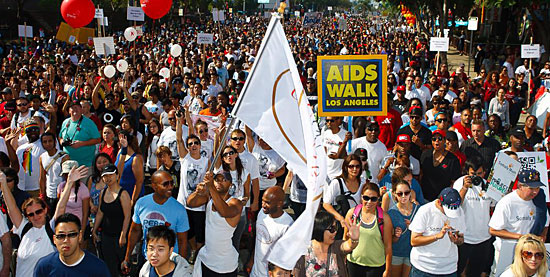
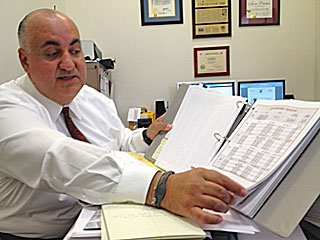
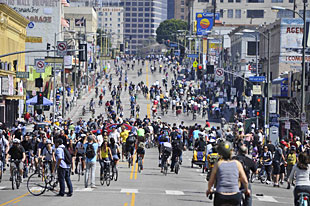


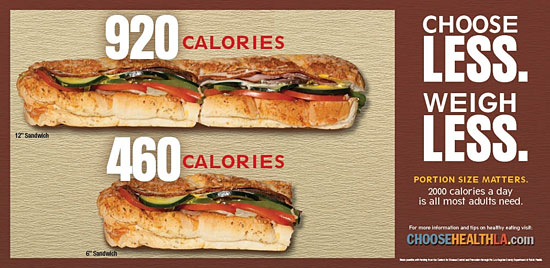

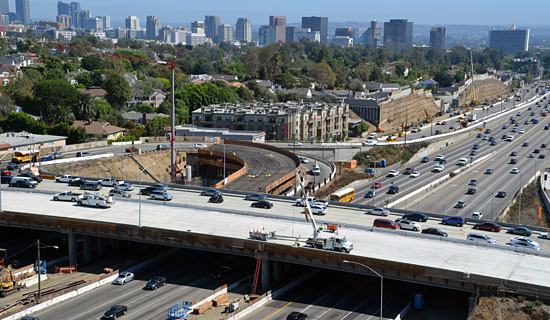
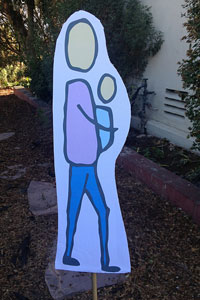
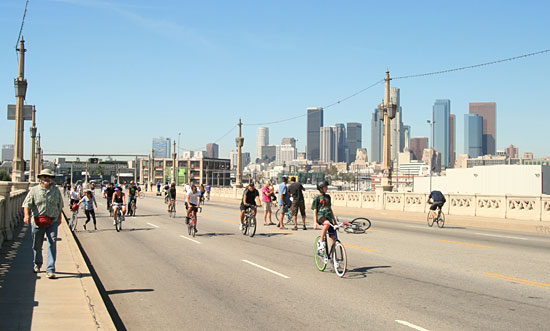





 Check for the latest closure information
Check for the latest closure information








